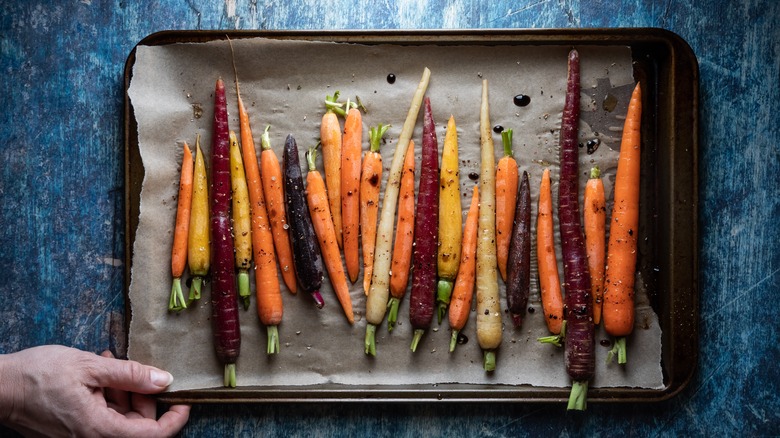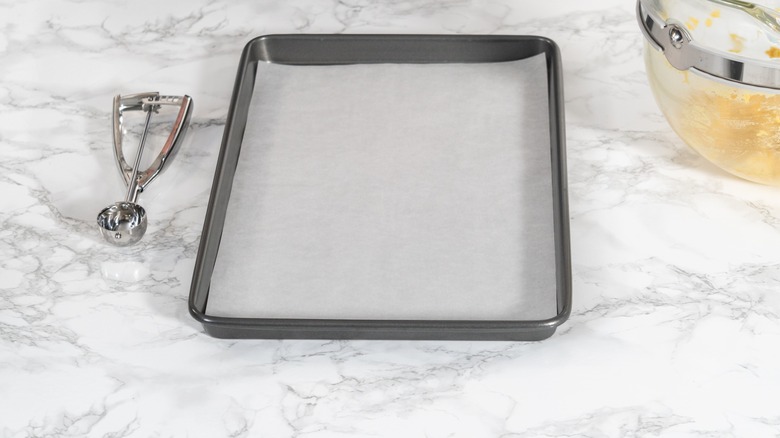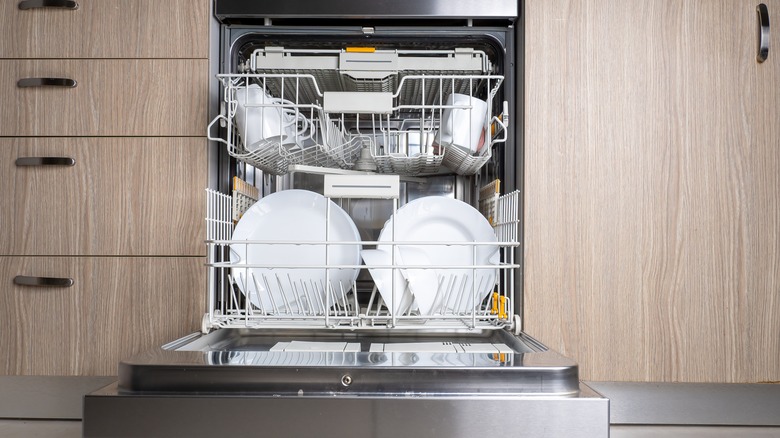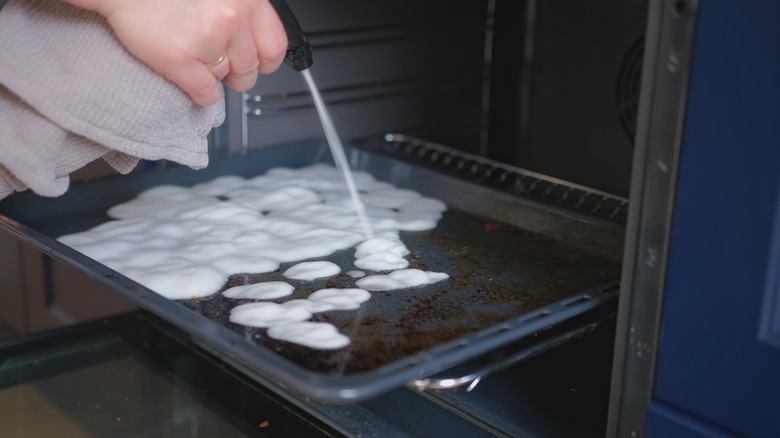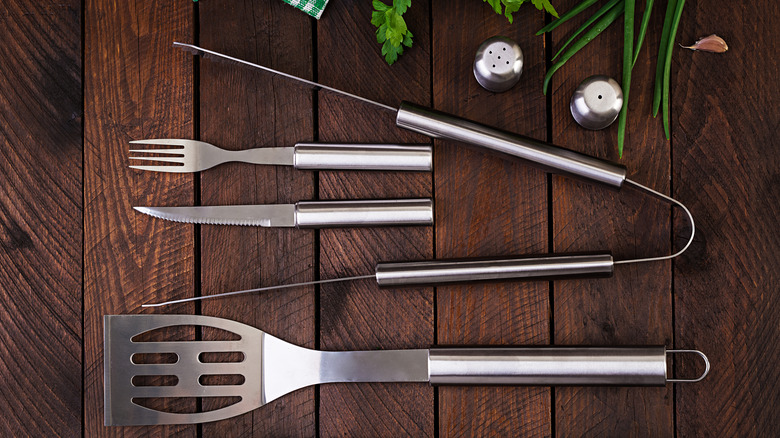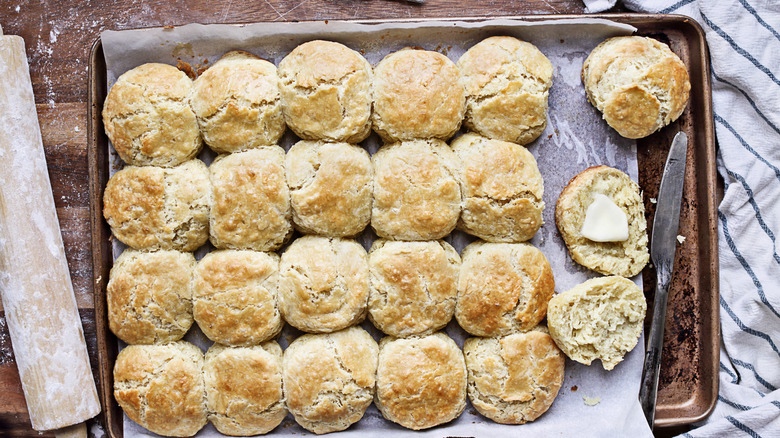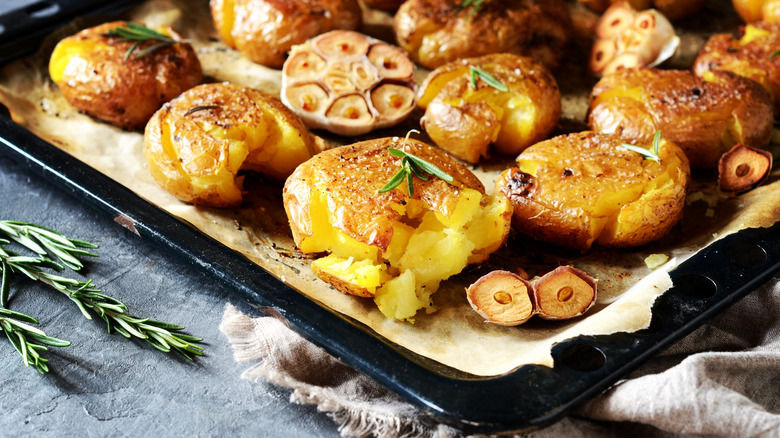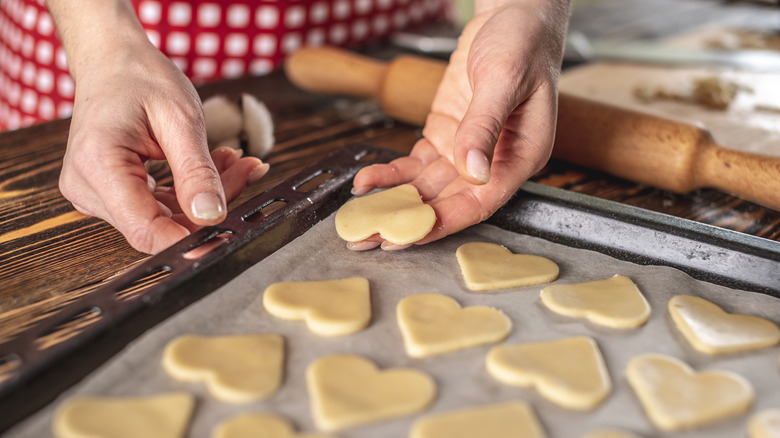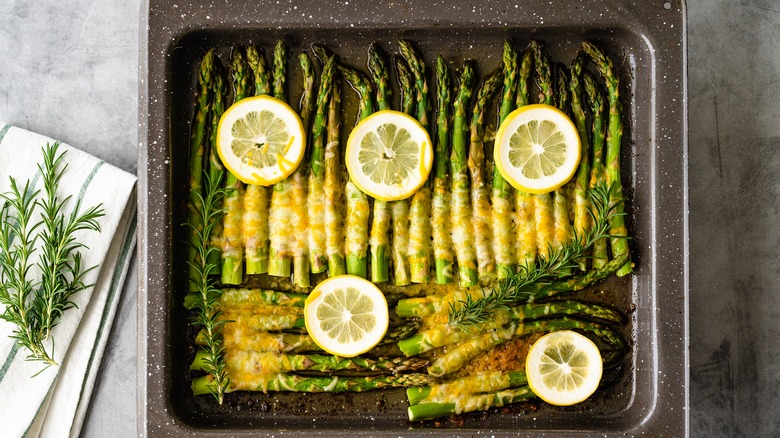8 Baking Sheet Mistakes You Want To Avoid
Baking sheets are one of the most commonly used items in the cooking world. They are used for anything from baking cookies, cakes, roasted veggies, and meats. While they are widespread, there are some mistakes that people might make that can impact the longevity of the sheet — and the quality of the food.
According to Home Cook World, baking sheets typically come in three standard sizes and are available in a variety of materials. The most common are stainless steel, aluminum, and non-stick-coated baking sheets. When treated correctly, baking sheets should last a long time: Brands such as Nordic Ware even offer lifetime guarantees for their products. But such warranties can be voided by improper use, some of which might surprise you. We will walk you through many of the common mistakes people make when using baking sheets. If you follow our lead, your sheet pans should last and continue to produce the best possible foods.
Using the wrong liner
Martha Stewart says one of the best ways you can extend the life of your baking sheets is by using a liner. There are many liners out there: Silicone mats, aluminum foil, and parchment paper are three of the more common choices. However, while each will protect your baking sheet, you can save your cooking by choosing the right liner for the job.
Noted pastry chef and food writer Stella Parks is a vocal proponent of avoiding silicone sheets when baking things like cookies. In fact, in an article she wrote for Serious Eats, Parks demonstrated how silicone sheets could completely alter a recipe. Parks baked several batches of cookies, one tray using parchment paper and one using silicone mats, and consistently showed the silicone mat cookies came out darker and spread more.
You may also want to ensure the proper liner is used when roasting vegetables. Nordic Ware notes under its care instructions that aluminum sheets react negatively to acidic foods such as vinegar and tomatoes, so a liner should be used. Likewise, Vegetarian Times recommends cooking vegetables on parchment paper, rather than foil, to decrease aluminum leaching; however, they do note that both can be used.
Putting them in the dishwasher
We know it is tempting to stick your baking sheets into the dishwasher after a long day of cooking, but please, do yourself a favor and resist that temptation. Most baking sheets are not dishwasher safe. Nordic Ware advises owners against putting baking sheets in the dishwasher as it can cause discoloration; they note that this does not affect the sheet's usefulness, but is still something you will want to avoid. More importantly, however, Nordic Ware also states washing pans in the dishwasher will void the warranty.
Home Cook World goes further to note that, in addition to cosmetic discoloration, it can cause metal sheets to rust and can cause the non-stick coating on some baking sheets to become damaged — All of which can severely limit the use of the baking sheet. Using a baking liner can help make baking sheet clean-up easy and help reduce the temptation to stick the baking sheets into the dishwasher. If, at the end of the day, you know you are someone who will always want to put them in the dishwasher, make sure you get baking sheets that are specifically dishwasher safe.
Cleaning incorrectly
In addition to not putting baking sheets in the dishwasher, as advised by Home Cook World, there are a few other cleaning no-nos we need to get through. First, while tough baked-on messes happen, do not reach for steel wool or other abrasive pan scrubbers. According to Nordic Ware, these abrasive cleaners will void their warranty.
For basic cleaning, The Seattle Times recommends using a sheet liner to reduce mess and simply using warm soapy water with a nonabrasive implement, such as a nylon brush or a washcloth. If the food still remains, let the sheet soak in warm soapy water to loosen baked-on messes. After soaking for some time, the sheets should come clean.
Finally, if all else fails, you can use a non-abrasive cleaner such as Bar Keepers Friend to remove build-up and tough pieces from the sheets, but only if they are plain metal without a non-stick coating. The best way is to use small circular motions and apply just enough pressure to help ease off the cooked-on food. With these methods, your baking sheets will stay clean and intact for years to come.
Using metal utensils
Using metal utensils on baking sheets will, at best, make them unattractive and, at worse, cause you to replace the sheets altogether. According to The Seattle Times, using metal utensils such as knives on an uncoated sheet will cause nicks and scratches to form on the sheet. While this will not directly affect their use, it will be unattractive. Additionally, it will cause your knife blade to dull, ruining two implements in one go (via Mr. Leonard's Knife Sharpening Service).
The problems with metal implements only worsen if you have a nonstick-coated sheet. Using metal utensils on nonstick-coated baking sheets can cause the coating to scratch and flake off, leading to small amounts making it into your food (via Healthline). As Healthline notes, this can be particularly problematic for sheets made before 2013, when they included the harmful chemical PFOA. To avoid these problems, Nordic Ware recommends only using nylon, wooden, or silicone-based utensils on their baking sheets.
Discarding old baking sheets
While discoloration may be a turn-off to some people, it is not a sign that baking sheets need to be replaced. As the Seattle Times describes, even with proper care, baking sheets will start to show signs of age and become darker in appearance over time — largely due to oils cooking onto the pans.
Many people are tempted to toss their baking sheets once these signs of age show up, but as the Seattle Times explains, that is the last thing you should do. As the sheets gain a brown layer — or patina — they start to conduct heat a little differently. The darker the sheet, the hotter they get — up to 50 degrees hotter, based on one experiment they cited. This can be ideal for roasting vegetables. While everyone may not like the look of darker sheets, the Seattle Times notes that pans are for cooking, not for show, so while you may want to keep them in mint condition, you might not be doing your cooking any favors.
Using warped baking sheets
Most people who bake have come across a warped baking sheet. This typically happens when sheets are exposed to extreme temperatures, such as going from cool room temperature to a very hot oven, or sticking a hot sheet under cool water (via Prudent Reviews). Unfortunately, while you may be tempted to use warped sheets, they can cause more trouble than they're worth.
A warped sheet will not be able to cook items such as jelly roll cakes, as the batter will pool unevenly. Additionally, one article from Cook'n describes how using a warped baking sheet can cause oil to pool when roasting, leading to uneven cooking. This can be annoying, but can also become a safety issue as oil can leak off the sheet and cause smoke, or even a grease fire.
To avoid warping baking sheets, try to avoid rapid temperature changes. Consider warming up your sheet as the oven preheats. Let the sheet cool before washing it, and avoid using low-quality sheets. Finally, while some warping may be fixable, if your baking sheets are permanently and severely warped, consider buying a new one.
Buying low quality baking sheets
Baking sheets are one of those items where it pays to get high-quality options. Of course, this does not necessarily mean going out and spending a fortune on the most expensive sheets available, but upgrading to a quality set of baking sheets will make a massive difference in the outcome.
First, as Cook'n states, high-quality baking sheets are less likely to warp than their cheaper counterparts. Checkered Chef notes that this is partially due to the thickness of the metal: Thicker baking sheets, in general, are less prone to warping.
Additionally, the type of metal the sheet is made of will affect the final product. Aluminum is the most common and affordable. Upgrading to a high-quality aluminum sheet can give you lasting benefits, according to Clean Eating, such as a quick heat-up time and typically some sort of non-stick coating. However, by upgrading to metal like stainless steel, you get a more durable sheet that is able to be physically a little thinner while still maintaining a high-quality level. Additionally, stainless steel conducts heat more evenly than its aluminum counterpart, but its downside is not being as non-stick as aluminum. So whatever you choose, make sure the sheet you buy is as high-quality as you can.
Distributing food unevenly
Finally, when cooking, make sure to distribute food evenly on the baking sheet. As Cook'n notes, unevenly distributing food can cause warm and cool spots on the sheet, which can then lead to warping. Additionally, Our Everyday Life notes that uneven heat distribution can cause baked goods such as cookies to bake unevenly. To keep the heat distribution uniform, spread food on the sheet evenly, and consider rotating the pan part of the way through the cooking time.
If you find that you do not have enough food to cover the baking sheet, WebstaurantStore says it is better to use a smaller sheet than to underload a larger one. Also, according to WebstaurantStore, standard baking sheets come in sizes that range from a full sheet pan, which is typically 18 inches by 26 inches, all the way down to an eighth of the size at 6.5 inches by 9.5 inches. So no matter how big your project is, there is probably a correct baking sheet size for you.
